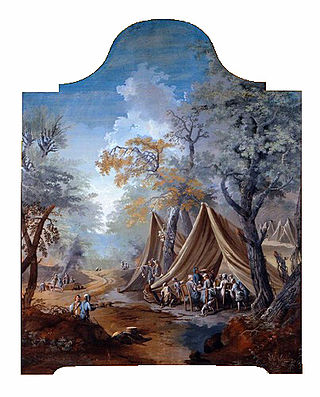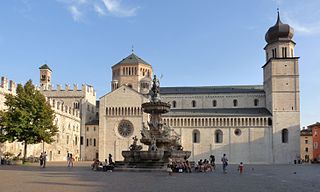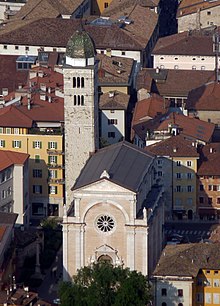
Bernardo Clesio was an Italian Cardinal, bishop, diplomat, humanist and botanist.
Basilica of St. Mary may refer to:

San Martino ai Monti, officially known as Santi Silvestro e Martino ai Monti, is a minor basilica in Rome, Italy, in the Rione Monti neighbourhood. It is located near the edge of the Parco del Colle Oppio, near the corner of Via Equizia and Viale del Monte Oppio, about five to six blocks south of Santa Maria Maggiore.

The Archdiocese of Bologna is a Latin Church ecclesiastical territory or archdiocese of the Catholic Church in Northern Italy. The cathedra is in the cathedral church of San Pietro, Bologna. The current archbishop is Cardinal Matteo Zuppi, who was installed in 2015.

Via dei Tribunali is a street in the old historic center of Naples, Italy.

Antonio Rossi (1700–1753) was an Italian painter of the late-Baroque or Rococo period, active mainly in Bologna.

The Archdiocese of Trento is a Latin Metropolitan archdiocese of the Catholic Church in the Triveneto, named after its see in Alpine Italy, Trento, in Trentino-Alto Adige region.

Santa Maria delle Vigne is a Roman Catholic basilica church in Genoa, Italy. It was built in the 10th century. The main altar was completed in 1730 by Giacomo Antonio Ponsonelli. The church is also the final resting place of the leading early Italian composer Alessandro Stradella, who was murdered in 1682.

The Basilica of San Giovanni Maggiore is a church in Largo San Giovanni Maggiore in central Naples, Italy.

The Palazzo della Compagnia dell'Arte dei Brentatori is a medieval palace located on Via de' Pignattari #11, starting at the Piazza Maggiore and running alongside the basilica church of San Petronio. It presently functions as the Hotel Commercianti, and a hotel at the site has existed for over a century.

Nepi Cathedral is a Neoclassical Roman Catholic cathedral located in Nepi, region of Lazio, Italy. It is dedicated to the Assumption of the Virgin Mary and to Saint Anastasia. It was the episcopal seat of the Diocese of Nepi, later Nepi and Sutri, suppressed in 1986, and is now a co-cathedral in the Diocese of Civita Castellana.
The following is a timeline of the history of the city of Trento in the Trentino-South Tyrol region of Italy.
The following is a timeline of the history of the city of L'Aquila in the Abruzzo, a region of Italy.

The Basilica of Santa Maria del Canneto, or Santa Maria Formosa, was a sixth-century Byzantine church erected in Pola under the patronage of Maximianus, bishop of Ravenna. The structure was damaged at the time of the Venetian sack of Pola in 1243, and building material was subsequently taken from the ruins and primarily incorporated into the Marciana Library and the Basilica of Saint Mark in Venice. Of the large, triple-nave church, comparable in splendour to the Euphrasian Basilica in Parenzo, only one of the lateral chapels survives. It constitutes the sole construction in Pola dating to the Byzantine period.

Crucifixion with Saints or Crucifixion with Mourners and Saints Bernardino of Siena, Francis of Assisi and Petronius is a 1583 oil on canvas, now in the church of Santa Maria della Carità in Bologna. The work was originally sited in the Macchiavelli chapel in San Nicolò di San Felice, Bologna, next to Santa Maria della Carità, which was destroyed by bombing during the Second World War. It was then temporarily moved to the Soprintendenza di Bologna and finally to its current home.
Paolo Prodi was an Italian historian and politician.
















